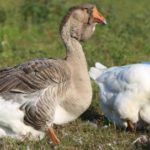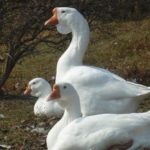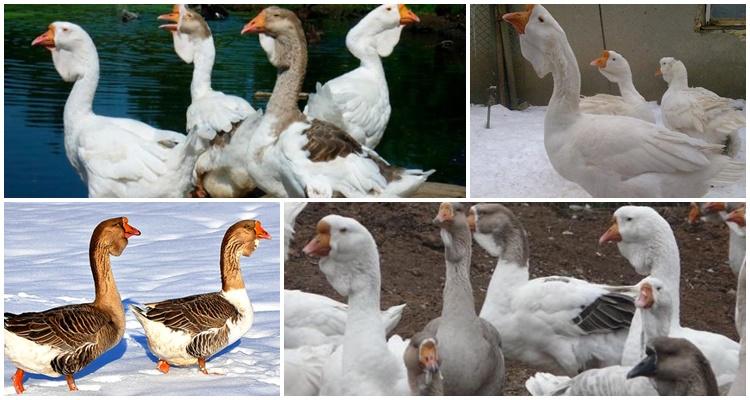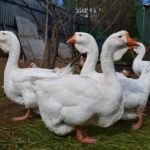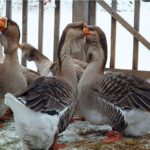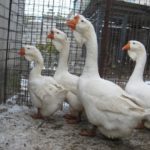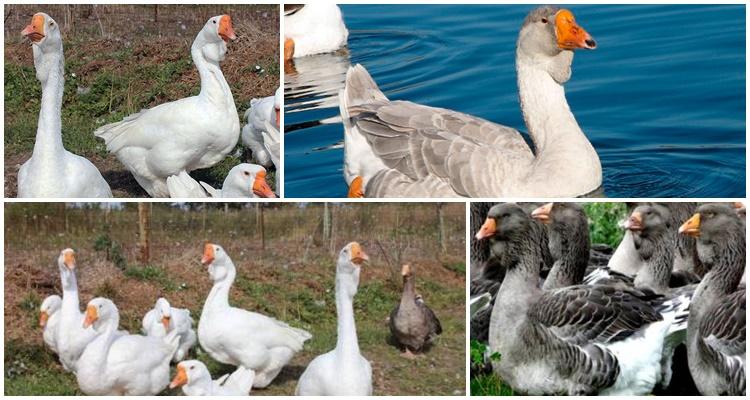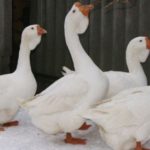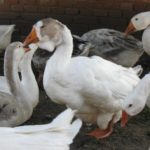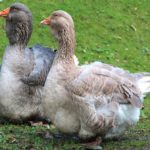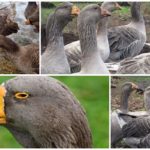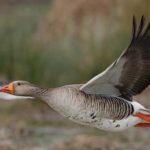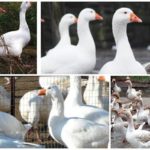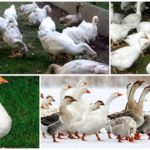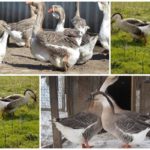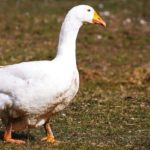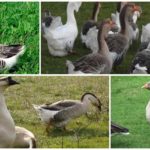The Kholmogory geese breed was bred a long time ago, but still withstands competition with new varieties. All thanks to excellent external and productive characteristics. Let's consider the description and characteristics of the Kholmogory geese breed, its main pros and cons. How to properly maintain, feed geese, care for and raise poultry on a private farm.
Origin story
Kholmogorskikh geese are classified as meat breeds. The breed was bred by folk selection in the 19th century in the central Russian regions.Local white and Chinese geese were used for crossbreeding. The result is a calm, hardy, unpretentious bird that can acclimatize to almost any conditions and not reduce productivity. Geese are resistant to disease and have a strong constitution.
What does the breed look like?
Geese of the Kholmogory breed have a horizontally placed round body and large breasts. The weight of an adult goose is 8 kg, a gander is 12 kg. The plumage is white, gray and intermediate piebald. External differences between the Kholmogors and other breeds are a bump at the base of the beak and a pronounced fold under it; a fold, clearly visible, is also present on the belly. The legs are orange, the beak of white geese is the same color, and that of dark geese is black.
During the war, the breed was almost lost, but thanks to the efforts of breeders, by 2024 Kholmogory geese look exactly the same as when they were bred.
Advantages and disadvantages
The advantages of the breed give reason to consider it one of the most promising for raising for meat on private farms.
Characteristics of Kholmogory geese
The size of adult Kholmogory individuals reaches 6-7 months. But development continues up to 3 years, by this time the bump on the beak is finally formed, the fertilization of eggs reaches 80%. The lifespan of geese of this Russian breed is 15-17 years. Females lay eggs weighing 180-200 g and lay 3 dozen eggs. Goslings at 2.5 months can weigh 4-4.5 kg.
Conditions and care
Geese of the Kholmogory breed were bred to adapt to the cold; they can be kept in any region of Russia. Any suitable utility room can be adapted for a goose barn or built specially. The poultry house should be dry, clean and light. Before birds move into it, you need to check the walls and ceiling and repair them so that there are no drafts, which geese do not like. For summer maintenance, you can organize a poultry house from a wooden frame, mesh covered with film or roofing felt.
The area of the poultry house is calculated based on the number of livestock; each bird should have 1 square meter. m. of space. The walking area is 2-3 times larger. Conditions of keeping: clean bedding and equipment. Sand, peat, straw or hay chaff are used for bedding. As soon as the litter becomes dirty and damp from droppings, it is replaced. The room is ventilated every day.
Goose house equipment - cleaning equipment, feeders and drinking bowls - must also be clean and disinfected. Feeders are made of metal for wet mixtures and wood for dry mixtures. The size of the feeders should be such that all the livestock can approach the food at the same time.
You should not allow many birds to live in the house at the same time. Crowding is always bad for pets. The proximity of individuals to each other, pollution of litter and air leads to mass diseases. To somehow solve this problem, Kholmogory geese can be kept in a walking yard all the time in the summer, if it is protected from precipitation and predators.
Features of feeding
The diet of Kholmogory geese does not differ from feeding geese other breeds.Kholmogory eat everything that is offered to them and do not go overboard with food. Their main food is fresh grass and wet mash. Mash is prepared from grain chaff, cake, bran, vegetables and root vegetables, and sprouted grains. If there is a pasture with grass nearby, the geese can be grazed there and only fed with grain in the evening.
If there is no opportunity to graze the bird, you need to feed it 2 or 3 times a day. Give grass clippings first, then grain mash. The amount of food should be such that the geese have time to eat it in half an hour. Water must be present in the house at all times; it must be changed every day. Geese fatten well on complete feed. Apart from mixtures and water, they don’t need anything else.
With proper feeding, Kholmogory geese begin to lay eggs in early spring. At this time, 1 hen needs about 150 g of grain, 100-150 g of grass or grass meal, 300-500 g of root vegetables. Premixes, chalk and salt are added to the mash to improve the quality of egg products and the strength of the shell. Fine gravel or sand is poured into a separate bowl. Birds need pebbles for normal digestion.
Goslings are kept for fattening for up to 5-6 months. Until this age, they grow rapidly and show the largest gains. Then the growth rate decreases, feed costs increase, and accordingly, the cost of production increases.
Subtleties of breeding
Until 5-6 months, it is difficult to distinguish Kholmogory geese by gender. Birds older than this age develop bumps on their beaks, which can be used to determine where the males are and where the females are.
A goose family for obtaining eggs is formed from 1 gander and 4 geese. In order for females to lay eggs, a nest must be placed in the poultry house for each family.You need to select the demolished fish every day if you plan to hatch young animals in an incubator. But you can leave the eggs to the females so that one of them decides to incubate. Kholmogory geese are responsible hens and caring mothers. The young under the goose are well preserved, do not get sick or die.
The temperature and humidity conditions for incubating eggs of Kholmogory geese are exactly the same as for other breeds of the species. Young animals can be hatched in a regular small incubator for home use.
After hatching, the goslings are raised in a brooder until they are one month old. In the first days, the brood is fed frequently - 6-7 times a day; by the age of one month, the frequency is increased to 3 times. The goslings' first food is a mixture of boiled eggs, cottage cheese, and herbs. From 3-4 days you can start giving cut grain. Take them out for walks a week after hatching, first for half an hour. 2-month-old goslings can be left outside all day.
Common diseases
Geese of the Kholmogory breed can suffer from infectious diseases. They are especially dangerous for young animals. If an infection occurs in a poultry house, the death of most of the flock can be expected. You should not wait until diseases appear; it is necessary to regularly carry out preventive treatments of poultry with antibacterial and antiviral drugs. When the first signs of illness appear, contact your veterinarian immediately.
Feeding disorders and poisonings are also common among turkeys. Their cause is improper feeding, improper selection of feed, and overfeeding. Control measures: review the composition of the diet, remove foods that can cause illness, keep turkeys without food for 24 hours.
What is the price?
The cost of a breeding Kholmogory goose varies depending on the region, the age of the bird and the owner’s requests. One bird is sold at a price of 1-5 thousand rubles. This is the amount they ask for for an adult goose that is laying eggs, and for an adult, mature gander. From breeding individuals you can get incubation material and your own young.
Geese of the ancient Kholmogory breed still do not lose their position as one of the best meat breeds. These are large birds with a large slaughter yield of meat. They are loved to be raised not only in the breed’s homeland, but also by poultry farmers in other regions of Russia and neighboring countries.


